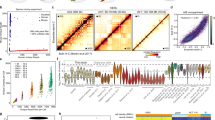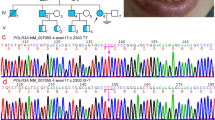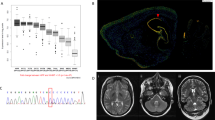Abstract
Autosomal recessive mutations in the GJA12/GJC2 gene encoding the gap junction protein connexin47 (C × 47) cause a form of Pelizaeus–Merzbacher-like disease (PMLD) with hypomyelination, nystagmus, impaired psychomotor development and progressive spasticity. We investigated the functional consequences of four C × 47 missense mutations (G149S, G236R, T265A, and T398I) and one C × 47 complex mutation (A98G_V99insT) by immunoblot analysis and immunocytochemistry in transfected communication-incompetent HeLa cells and in OLI-neu cells. All studied C × 47 mutants, except G236R, generated stable proteins in transfected HeLa cells and OLI-neu cells. The mutants T265A and A98G_V99insT were retained in the ER, T398I formed gap junctional plaques at the plasma membrane, and G149S showed both, structures at the plasma membrane and ER localization. Two-microelectrode voltage clamp analyses in Xenopus laevis oocytes injected with wild-type and mutant C × 47 cRNA revealed reduced hemichannel currents for G236R, T265A, and A98G_V99insT. In contrast, T398I revealed hemichannel currents comparable to wild-type. For C × 47 mutant T398I, our results indicate a defect in hemichannel function, whereas C × 47 mutants G149S, G236R, T265A, and A98G_V99insT are predicted to result in a loss of C × 47 hemichannel function. Thus, PMLD is likely to be caused by two different disease mechanisms: a loss of function and a dysfunction.
Similar content being viewed by others
Log in or create a free account to read this content
Gain free access to this article, as well as selected content from this journal and more on nature.com
or
References
Saugier-Veber P, Munnich A, Bonneau D et al: X-linked spastic paraplegia and Pelizaeus–Merzbacher disease are allelic disorders at the proteolipid protein locus. Nat Genet 1994; 6: 257–262.
Schiffmann R, Boespflug-Tanguy O : An update on the leukodystrophies. Curr Opin Neurol 2001; 14: 789–794.
Uhlenberg B, Schuelke M, Rüschendorf F et al: Mutations in the gene encoding gap junction protein alpha 12 (connexin 46.6) cause Pelizaeus–Merzbacher-like disease. Am J Hum Genet 2004; 75: 251–260.
Bugiani M, Al Shahwan S, Lamantea E et al: GJA12 mutations in children with recessive hypomyelinating leukoencephalopathy. Neurology 2006; 67: 273–279.
Salviati L, Trevisson E, Baldoin MC : A novel deletion in the GJA12 gene causes Pelizaeus–Merzbacher-like disease. Neurogenet 2007; 8: 57–60.
Wolf NI, Cundall M, Rutland P et al: Frameshift mutation in GJA12 leading to nystagmus, spastic ataxia and CNS dys-/demyelination. Neurogenet 2007; 8: 39–44.
Henneke M, Combes P, Diekmann S et al: GJA12 mutations are a rare cause of Pelizaeus–Merzbacher-like disease. Neurology 2008; 70: 748–754.
Orthmann-Murphy JL, Salsano E, Abrams CK et al: Hereditary spastic paraplegia is a novel phenotype for GJA12/GJC2 mutations. Brain 2009; 132: 426–438.
Wang J, Wang H, Wang Y, Chen T, Wu X, Jiang Y : Two novel gap junction protein alpha 12 gene mutations in two Chinese patients with Pelizaeus–Merzbacher-like disease. Brain Dev 2009; 32: 236–243.
Trosko JE, Ruch RJ : Cell–cell communication in carcinogenesis. Front Biosci 1998; 3: D208–D236.
Kumar NM, Gilula NB : The gap junction communication channel. Cell 1996; 84: 381–388.
Nagy JI, Dudek FE, Rash JE : Update on connexins and gap junctions in neurons and glia in the mammalian nervous system. Brain Res Brain Res Rev 2004; 47: 191–215.
Rash JE, Yasumura T, Dudek FE, Nagy JI : Cell-specific expression of connexins and evidence of restricted gap junctional coupling between glial cells and between neurons. J Neurosci 2001; 21: 1983–2000.
Massa PT, Mugnaini E : Cell junctions and intramembrane particles of astrocytes and oligodendrocytes: a freeze-fracture study. Neuroscience 1982; 7: 523–538.
Nagy JI, Ochalski PAY, Li J, Hertzberg EL : Evidence for the colocalization of another connexin with connexin-43 at astrocytic gap junctionsin rat brain. Neuroscience 1997; 78: 533–548.
Menichella DM, Goodenough DA, Sirkowski E, Scherer SS, Paul DL : Connexins are critical for normal myelination in the CNS. J Neurosci 2003; 23: 5963–5973.
Odermatt B, Wellershaus K, Wallraff A et al: Connexin 47 (C × 47)-deficient mice with enhanced green fluorescent protein reporter gene reveal predominant oligodendrocytic expression of cx47 and display vacuolized myelin in the cns. J Neurosci 2003; 23: 4549–4559.
Giaume C, Fromaget C, El Aoumari A, Cordier J, Glowinski J, Gros D : Gap junctions in cultured astrocytes: single-channel currents and characterization of channel-forming protein. Neuron 1991; 6: 133–143.
Nagy JI, Li X, Rempel J et al: Connexin26 in adult rodent central nervous system: demonstration at astrocytic gap junctions and colocalization with connexin30 and connexin43. J Comp Neurol 2001; 441: 302–323.
Orthmann-Murphy JL, Freidin M, Fischer E, Scherer SS, Abrams CK : Two distinct heterotypic channels mediate gap junction coupling between astrocyte and oligodendrocyte connexins. J Neurosci 2007b; 27: 13949–13957.
Orthmann-Murphy JL, Enriquez AD, Abrams CK, Scherer SS : Loss-of-function GJA12/Connexin47 mutations cause Pelizaeus-Merzbacher-like disease. Mol Cell Neurosci 2007a; 34: 629–641.
Jung M, Krämer E, Grzenkowski M et al: Lines of murine oligodendroglial precursor cells immortalized by an activated neu tyrosine kinase show distinct degrees of interaction with axons in vitro and in vivo. Eur J Neurosci 1995; 7: 1245–1265.
Barrio LC, Suchyna T, Bargiello T et al: Gap junctions formed by connexins 26 and 32 alone and in combination are differently affected by applied voltage. Proc Natl Acad Sci USA 1991; 88: 8410–8414.
Barish ME : A transient calcium-dependent chloride current in the immature Xenopus oocyte. J Physiol 1983; 342: 309–325.
Ebihara L : New roles for connexons. News Physiol Sci 2003; 18: 100–103.
Kozak M : Interpreting cDNA sequences: some insights from studies. Mamm Genome 1996; 7: 563–574.
Foote CI, Zhou L, Zhu X, Nicholson BJ : The pattern of disulfide linkages in the extracellular loop regions of connexin 32 suggests a model for the docking interface of gap junctions. J Cell Biol 1998; 140: 1187–1197.
Dhaunchak AS, Nave KA : A common mechanism of PLP/DM20 misfolding causes cysteine-mediated endoplasmic reticulum retention in oligodendrocytes and Pelizaeus–Merzbacher disease. Proc Natl Acad Sci USA 2007; 104: 17813–17818.
Olbina G, Eckhart W : Mutations in the second extracellular region of connexin43 prevent localization to the plasma membrane, but do not affect its ability to suppress cell growth. Mol Cancer Res 2003; 1: 690–700.
Moreno AP, Lau AF : Gap junction channel gating modulated through protein phosphorylation. Prog Biophys Mol Biol 2007; 94: 107–119.
Britz-Cunningham SH, Shah MM, Zuppan CW, Fletcher WH : Mutations of the connexin 43 gap-junction gene in patients with heart malformations and defects of laterality. New Engl J Med 1995; 332: 1323–1329.
Omori Y, Mesnil M, Yamasaki H : Connexin 32 mutations from X-linked Charcot–Marie–Tooth disease patients: functional defects and dominant negative effects. Mol Biol Cell 1996; 7: 907–916.
Castro C, Gómez-Hernandez JM, Silander K, Barrio LC : Altered formation of hemichannels and gap junction channels caused by C-terminal connexin32 mutations. J Neurosci 1999; 19: 3752–3760.
Kondo RP, Wang SY, John SA, Weiss JN, Goldhaber JI : Metabolic inhibition activates a non-selective current through connexin hemichannels in isolated ventricular myocytes. J Mol Cell Cardiol 2000; 32: 1859–1872.
Liang GS, de Miguel M, Gómez-Hernández JM et al: Severe neuropathy with leaky connexin32 hemichannels. Ann Neurol 2005; 57: 749–754.
Deschênes SM, Walcott JL, Wexler TL, Scherer SS, Fischbeck KH : Altered trafficking of mutant connexin32. J Neurosci 1997; 17: 9077–9084.
Orthmann-Murphy JL, Abrams CK, Scherer SS : Gap junctions couple astrocytes and oligodendrocytes. J Mol Neurosci 2008; 35: 101–116.
Gow A, Lazzarini RA : A cellular mechanism governing the severity of Pelizaeus–Merzbacher disease. Nat Genet 1996; 13: 422–428.
Gow A, Southwood CM, Lazzarini RA : Disrupted proteolipid protein trafficking results in oligodendrocyte apoptosis in an animal model of Pelizaeus–Merzbacher disease. J Cell Biol 1998; 140: 925–934.
D’Urso D, Prior R, Greiner-Petter R, Gabreëls-Festen AA, Müller HW : Overloaded endoplasmic reticulum–Golgi compartments, a possible pathomechanism of peripheral neuropathies caused by mutations of the peripheral myelin protein PMP22. J Neurosci 1998; 18: 731–740.
Aridor M, Balch WE : Integration of endoplasmic reticulum signaling in health and disease. Nat Med 1999; 5: 745–751.
Gow A, Friedrich VL, Lazzarini RA : Many naturally occurring mutations of myelin proteolipid protein impair its intracellular transport. J Neurosci Res 1994; 37: 574–583.
Acknowledgements
We thank J Kaiser and I Markmann for technical assistance and H Werner and P De Monasterio for providing OLI-neu cells. This study was supported by the Deutsche Forschungsgemeinschaft grant number GA354/6-1 (to JG and MH).
Author information
Authors and Affiliations
Corresponding author
Ethics declarations
Competing interests
The authors declare no conflict of interest.
Additional information
Supplementary Information accompanies the paper on European Journal of Human Genetics website
Supplementary information
Rights and permissions
About this article
Cite this article
Diekmann, S., Henneke, M., Burckhardt, B. et al. Pelizaeus–Merzbacher-like disease is caused not only by a loss of connexin47 function but also by a hemichannel dysfunction. Eur J Hum Genet 18, 985–992 (2010). https://doi.org/10.1038/ejhg.2010.61
Received:
Revised:
Accepted:
Published:
Issue date:
DOI: https://doi.org/10.1038/ejhg.2010.61
Keywords
This article is cited by
-
Novel mutations in the GJC2 gene associated with Pelizaeus–Merzbacher-like disease
Molecular Biology Reports (2019)



